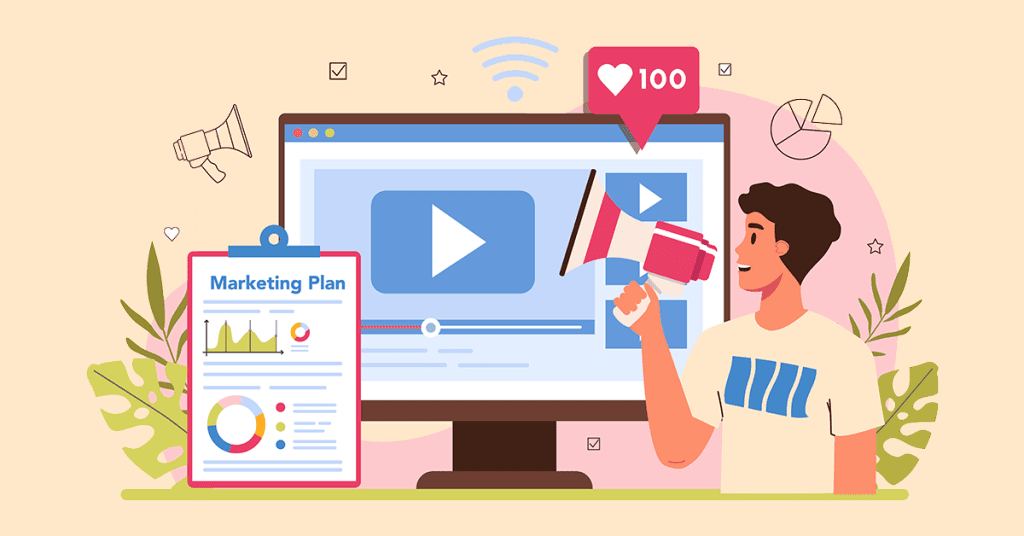The ecommerce industry has exploded in recent years. In 2020 alone, Statista reported over two billion people purchased goods or services online. During the same year, e-retail sales surpassed $4.2 trillion worldwide.
Social media for ecommerce has become a critical element in sales growth. Just consider the statistics that have emerged from these valuable channels. After following a brand on social media, consumers will continue to engage in a variety of ways – 91% will visit the brand’s website or app, 89% will make a purchase and 85% will recommend it to a family or friend.
There are many social media marketing strategies that ecommerce stores use to increase their presence. In this blog post, we discuss some of the best social media tactics to take your ecommerce business to the next level.
Start a blog
When an ecommerce business builds a website, they should create a blog to share all their tips, tricks, and expert advice. Blogs are also an excellent way for ecommerce owners to showcase their business in action, so be sure to document your activity in detail.

Popular ecommerce styling company HairFlair runs a blog section that provides tips, tricks and insights for their readers – but they ensure their articles are informative and guide visitors to products in a bid to convert more sales.
Blog articles can be linked to social media channels in the form of Instagram stories or social posts, which can drive traffic from social to your blog.
Ultimately, this can push visitors to purchase from your site if blog posts are optimized with internal links to category and product pages.
Improving the backend operations with efficient logistics can significantly boost your ecommerce business’s fulfillment speed and customer satisfaction.
Partnering with third-party logistics providers not only streamlines your supply chain but also applies the latest technology in logistics and supply management to elevate your operational efficiency. This strategic move allows ecommerce businesses to focus on scaling their market reach while ensuring the best for their product delivery dynamics.
Build social media ads
Create eye-catching social media ads targeting people who are searching for stores to purchase from. For example, a fashion & apparel store may target people with engaging posts on the latest trends, style inspiration and new products hitting the market.
It’s important that you understand which social media platforms are most popular with your target audience before placing the ads. Identify where your target audience is most engaged and most accessible, and place the ads accordingly with that information in mind.
Then, create the content they want to see. If you’re targeting younger audiences on TikTok, for example, you’ll need a fun video that’s capable of going viral. If you’re targeting a Facebook audience with a niche interest, work out the type of content they like to consume and replicate that.
Increase engagement
Social media followers typically engage with their favorite brands and ecommerce stores on social media by liking posts, commenting, and posting content of their own – such as fashion inspiration photos.
In addition to building your audience base, increasing social media engagement is another great strategy. Try using contests to build engagement. Provide your followers with opportunities to enter by hosting weekly contests that require certain actions in order to win – such as a retweet, like, share or even purchase.
Alternatively, engage with your audience through community management. Respond to their tweets and comments and repost their user generated content on your channels to start building strong customer relationships. Social interactions are all important customer touchpoints that can be used to maintain a positive brand relationship with existing and potential customers.
You can also use a search tool to monitor the behavior of customers on your website. It gives you the chance to not only check the total amount of searches performed on your site but also many other benefits that might come in handy for interacting with the customers more effectively.
Use strategic hashtags
Hashtags are an excellent way to increase visibility and reach new audiences with no previous exposure to your brand.

Ecommerce fashion brands can find plenty of hashtag examples available to them on Instagram
For example, you could start an Instagram trends account on fashion trends throughout history. You can then include ecommerce-related hashtags in order to increase visibility amongst people with those interests.
It’s easier than ever before to find content tailored to specific audience needs, so take advantage of this with strategic hashtags. You’ll also find a bunch of specific Instagram tools that can help take your profile on this social platform to the next level.
Network
If you have a Twitter account, try tagging other ecommerce stores in tweets that could catch their eye.
This also works for Facebook pages – tag other brands or personalities in your posts to encourage engagement and shares.
You can even schedule pre-written tweets about the latest ecommerce news, products or events.
Post photos regularly
Images are incredibly important on all forms of social media – not just Instagram. Pinterest is another site where images play a huge role since people often search through pins using keywords and ecommerce-related hashtags.
In fact, ecommerce pins with images tend to get re-pinned more often than those without.

Example of ecommerce website The Goodness Project utilising their social media feed by displaying high quality images of their products.
It’s time to put your best selfie forward and make it a highly-shared one. Studies show that including images in social media posts is the most important aspect of effective marketing.
Make sure you optimize these pictures so that they’re shareable on sites like Instagram or Pinterest (i.e., include our “Pin It” button). You can even get creative with customer selfies by featuring those that show off your products – this will really boost sales if it’s well executed.
Ensure you create a regular posting schedule with high quality images that are both informative and engaging to help build your brand image and recognition.
Include CTA buttons on all ecommerce social media posts
Be sure that you have a solid call to action (CTA) in every ecommerce post – whether it’s asking for likes or shares or purchasing your products directly from the post itself.
Having a good CTA will improve conversion rates, boost sales and maximize engagement.

The phrase Everything Will Sell Out! in this web copy by Pura Vida Bracelets uses Fear of Missing Out tactics to emphasise that stocks are limited and motivates its audience to act immediately.
Interact with your followers
Social media is the perfect platform for connecting with prospects and customers.
Monitor your posts daily, respond to questions and comments from your audience and also give good customer service by engaging followers in conversations about their posts.
You may find that social media can quickly become a customer service channel, with customers hoping to get quick responses. Some bigger brands make specific customer service profiles to address these issues and split this from the main “brand” profile.
Ensuring you engage and respond to users in a timely and helpful manner all plays a part in providing a good digital customer experience.
This builds a connection with your audience, while it’s also an easy way to demonstrate the value they’ll get from your product or service.
To interact with your followers you can:
- Join groups: Participating in groups is a great way to pick up the important keywords. You can comb through posts and retweets, and share or repost articles that may prompt prospects and customers into following you. It’s also good for establishing rapport online by responding positively when people comment about your work.
- Build relationships with influencers: How many times have you seen a celebrity post about their latest travel adventure and felt like it’s worth following them because of how genuine they seem? Influencers help build trust with customers, which is why influencer relations are becoming increasingly important. Influencers can drive sales and boost a brand’s reach. Building relationships with influencers will help you extend your influence, which in turn boosts trust for your product or service.
- Host live chats: Imagine having an instant conversation with someone in your industry or field. What would you chat about? It turns out that people love live chats, which are perfect for sharing the latest industry news and answering questions from viewers.
Optimize your posts
Optimizing posts with specific keywords is a great way to earn more exposure. By incorporating relevant keywords and hashtags into social posts, marketers can push content towards their desired audience.
Images or videos should also feature heavily when creating an optimized ecommerce store page, as visually orientated advertisements are preferred over text heavy copywriting style ads.
Master paid advertising
There are multiple ways to market your product online and pay-per-click (PPC) advertising is an important tool in today’s internet economy.
Though it carries a price tag, this form of marketing reaches audiences who may not otherwise see your content – for example, people who don’t follow your social media profiles.
Moreover, ecommerce sites can use retargeting campaigns to reach customers who have previously engaged with – or even purchased from – their brand. Retailers know that social media is one of the best ways to drive traffic and attract customers, so these platforms should be fully utilized.
However, advertisers need to be specific with who they target. Rather than aiming to appeal to a broad range of people, advertisers should craft a highly refined audience with the maximum potential to convert into sales.
The types of targeting options that most PPC platforms offer include factors like:
- Age
- Gender
- Location
- Income
- Interests
- Languages
Additionally, destinations like Facebook provide sellers with the means to target Custom Audiences and Lookalike audiences. This is accomplished through creating a list of people similar in nature or closely resembling your existing customer base – these are called “Custom” audiences.
Optimize your landing pages
Landing pages are important because they help people make decisions and complete purchases. If you want a user to buy from your site, it’s imperative that landing pages provide enough information to reassure customers about their purchase.
Ensure that images and videos are high quality, you’ve effectively used social proof, described features clearly and provide CTAs that lead users through a straightforward checkout line.
Use social media to A/B test
One way to improve conversion rates is through split testing. One of the most important things any online marketer should do before investing in new digital marketing campaigns is to split test their website, ensuring that the traffic they’re driving from social media converts on the site.
Split testing, also referred to as A/B testing, allows you to make data-driven decisions about your business’ future and determine the best strategy for increasing sales and conversion rates. By running split tests on different aspects of your site (such as color schemes, layouts etc.), you can establish which settings result in better engagement with customers.
Final thoughts on social media tactics
If you want to be competitive online, integrating social media into your marketing mix is essential. The key to driving sales on your ecommerce store from social media is to test your social handles and work out where your customers are most active. Engage with them there, develop connections along the way and drive traffic to optimized landing pages.
With the right strategy and social media tactics in place, you can improve brand awareness and increase conversions while increasing customer engagement rates. Ultimately, a strong and well constructed social media presence will help grow your ecommerce business.

